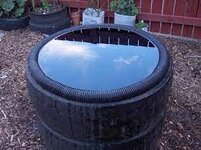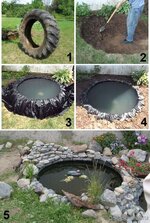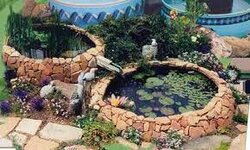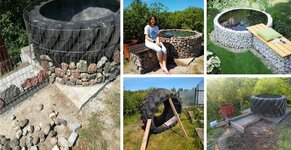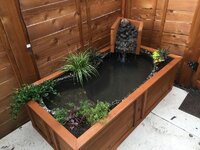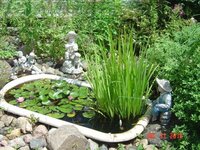axolotl nerd
Well-known member
- Joined
- Mar 17, 2021
- Messages
- 1,132
- Reaction score
- 452
- Points
- 83
- Location
- oklahoma
- Country
- United States
- Display Name
- ren
introduction
i‘ve wanted to have a sanctuary and breeding facility for axolotls for as long as i can remember, and have recently started researching and planning to start one.
this thread is meant to document my plans, ideas, progress, and eventual launch of my sanctuary//breeding program- assuming i get that far (fingers crossed!)
background information
*more information on my college considerations and related subjects in section “basic outline”
**two of the three axolotls were rescued from my schools lab. they were being mistreated and neglected, and likely would’ve died if there was no intervention- i could write all day about everything that was wrong with their husbandry, but i digress. they are now healthy and happily living with a close friend of mine
basic outline
*pet stores would have to be personally inspected by myself before i even consider selling to them. i would come into the store a minimum of once weekly to ensure good husbandry and care, as well as require that every animal is sold with a copy of the comprehensive care guide ive written. i have very strict standards, but would possibly sell to a pet store
breeding musings//ideas
*more on this in section “outdoor colony ideas”
*more on culling in section “culling, the necessary evil”
culling, the necessary evil
outdoor colony ideas
that’s all for the moment, but this document will be updated as i continue to plan and implement my ideas
and finally…
if you have any ideas, questions, or suggestions for my plan, please feel free to respond! notice anything that seems off? don’t agree with something? have a better suggestion? let me know!
with love,
i‘ve wanted to have a sanctuary and breeding facility for axolotls for as long as i can remember, and have recently started researching and planning to start one.
this thread is meant to document my plans, ideas, progress, and eventual launch of my sanctuary//breeding program- assuming i get that far (fingers crossed!)
background information
- i am 17 years old, and live in oklahoma
- i have a well paying job and i have started saving to rent an apartment, then eventually purchase a home
- i do not currently plan on going to college, however that is subject to change*
- i have kept axolotls for around 2 years, and have had three adult females so far, all of which are healthy and happy**
- i currently have one axolotl, an axanthic female named mudkip. i adore her dearly
*more information on my college considerations and related subjects in section “basic outline”
**two of the three axolotls were rescued from my schools lab. they were being mistreated and neglected, and likely would’ve died if there was no intervention- i could write all day about everything that was wrong with their husbandry, but i digress. they are now healthy and happily living with a close friend of mine
basic outline
- beginning steps
- firstly, this spring or summer i plan on purchasing axolotl eggs from a local breeder. i intend to get around ten, hopefully five pairs of twins, and ideally with the GFP gene, as i’m running a (humane) genetic experiment. assuming all are viable and healthy, which i understand is not likely, i will raise the larve to juvenile or young adult stages, then sell them. this will be my first step into becoming a breeder and will help me get a feel for how difficult caring for hatchlings will be, as well as better understand the market (shipping, selling to pet stores,* pricing, etc.)
- next, i need to graduate high school. i wont go into detail on this, but the school i attend is very difficult and i have quite a bit of studying or homework a night, hence my hesitation in raising large quantities of juveniles until after i’m out of school
- from there, i have a decision to make; college, or not. at the moment i do not plan on attending college, but am open to advice from people wiser than i. if i do end up going to college, i’ll likely major in zoology and minor in business, as owning a sanctuary and breeding animals in order to run that sanctuary requires some knowledge in business, id imagine. i also did excellently in zoology my sophomore year, ending both semesters with a high “a” in the class. (not to brag or anything hehe)
*pet stores would have to be personally inspected by myself before i even consider selling to them. i would come into the store a minimum of once weekly to ensure good husbandry and care, as well as require that every animal is sold with a copy of the comprehensive care guide ive written. i have very strict standards, but would possibly sell to a pet store
- moving out, renting an apartment, etc.
- assuming i don’t go to college, my plan consists of renting a small apartment for a few years, breeding axolotls out of there, and saving up for a proper house.
- i also intend to quit my current job (high stress, but $14/hour, hence why i still work there) and begin working at a local pet store. the employees ive spoken with, as i’m in there often looking at things for my darling mudkip, have recommended i apply when i turn 18. the fish specialist i spoke with urged me to speak with the manager, and i did. i was told the job was essentially mine provided i don’t have a criminal record or anything questionable like that. (which i don’t, to be clear) if i get hired, id both be making money and getting a discount on store items, such as things necessary for my breeding//rearing plans. a double edged sword, really, as i could find myself spending money on things i don’t necessarily need, (substrate, tank decor, plants, etc.) but i intend to keep myself on a strict budget
- purchasing a home, beginning my sanctuary
- once ive saved enough to afford a small home, (with a backyard, and hopefully a nice cool basement!) i plan on starting to build my sanctuary.
- from that point, i will likely begin housing my non-breeding axolotls outdoors in filtered, monitored, and protected ponds made from various upcycled materials
- advanced sanctuary plans
- as the dream grows and i obtain more animals, i would like to open my sanctuary to the public. tours, viewing, and information about them would be 100% free, while things such as viewing feedings, visiting gravid/laying females, watching eggs being hatched, etc. would have a small charge. (likely only $10-15, as i would like the experience to be available to most)
- hopes for the future
- the eventual goal is to breed and sell axolotls for a living, run a sanctuary as an information and conservation effort, and support myself as well as my animals full time. though i understand this will take many years, is not even ensured to be successful, and could quite easily crash and burn, i believe that if i give all my attention and ambition to this project, it’s possible (then again, i’m a teenager with a big heart and bigger dreams)
breeding musings//ideas
- starting out
- i would start breeding beginning with mudkip and her future breeding partner, and gradually building and adding more diversity to the gene pool. (via purchasing eggs, juveniles, and adults for breeding purposes from sources around the states)
- once ive sold enough offspring to afford more animals, i would also like to be a sort of rescue center, in which people could contact me and give up axolotls they can no longer care for. all animals would be quarantined for a minimum of a month before joining the breeding system or outdoor colony*
*more on this in section “outdoor colony ideas”
- genetics & inbreeding prevention
- i fully intend to keep my gene pool as diverse as possible, and am likely to change breeding pairs every so often. i will likely have a group of ten adults that i breed from, and will document who breeds with who to ensure no inbreeding occurs.
- a quick note; i am highly against inbreeding, and though i understand all axolotls are inbred to some degree, i absolutely will not contribute to the muddled gene pool by allowing directly inbred (that is, sibling//sibling, parent//offspring, or cousin//cousin) individuals into the pet trade.
- any inbred offspring will be culled as soon as eggs are discovered,* however, i plan on keeping animals separated by sex, so this shouldn’t be a problem
- any offspring i may have that are hatched with deformities, neurological problems, or otherwise issues will be either culled, kept solitarily, or in a small group of monitored of same-sex individuals- depending on the severity of the problem.
*more on culling in section “culling, the necessary evil”
culling, the necessary evil
- overview
- i may have a big heart for animals, especially axolotls, but i fully acknowledge culling is a necessity at times. thus, i decided to document my current position on what kinds of animals should be culled, and the process i would go about doing so
- position on culling
- first off, my opinion on what animals should be culled. i personally believe that if an animal is able to eat, function, and pass waste, (and seems to be content) without hindrance or considerable difficulty, they have the right to live. therefore, i believe that axolotls with bent spines, neurological disorders, bodily deformities, or other issues should have a chance. oftentimes i see dwarves or animals with bent spines euthanized early on in life, but i advocate to give them a chance at a normal, happy life- provided they can preform basic functions. however, that is not to say that an animal who is unable to live without considerable and irreparable pain should continue on. i don’t condone euthanasia unless the animal is in clear pain, or would die in a slow, difficult way without it. ergo, if an animal has something “wrong” with it, and cannot eat, pass waste, or otherwise function, i believe it would be kindest to humanely euthanize. it is naïve to think we can save all animals, but we must take a chance on some, even if they require a bit of special care
- preferred methodology in euthanasia
- secondly, the process in which i would euthanize an axolotl. if the animal is merely an egg, and less than 5 days old, i would simply put them in the freezer (as they have no nerves before the age of 5 days old, freezing wouldn’t be a painful way to go.) if an egg is above the age of 5 days, a clove oil overdose would be my route of choice, as clove oil acts as an anesthesia in axolotls. if an animal is a hatchling, juvenile, or adult, clove oil overdose would also be the most likely course of action. i’m currently researching drugs that can be used to euthanize after the animal has been anesthetized, but have discovered that legally obtaining such drugs without being a veterinarian or chemistry instructor is rather difficult.
outdoor colony ideas
- general information
- i would like to have and outdoor area dedicated to my rescue and non-breeding axolotls. ive done my research on general pond matinence and upkeep, and feel well prepared to have a few in my yard
- building materials
- i would use upcycled materials such as used tractor tires with pond liners inside them, reused galvanized stock tanks, old bathtubs, hand-dug ponds with liners inside, and probably a few (not upcycled, but still good) premade plastic pond liners.
- separation and other general information
- ponds will be separated by sex and size, monitored daily, covered by mesh netting to avoid predation, heavily shaded and deep to avoid overheating. i also intend to collect each animal at least once a month for a regular health check up, and to make sure there isn’t any cannibalism occurring.
- contamination and predation prevention
- ponds would be in a fenced backyard, in hopes of avoiding contamination of the local environment and preventing predation. as aforementioned in section b of “outdoor colony ideas,” every pond would also have a sort of protective netting over the top of it.
- potential technicality issues
- living in oklahoma, the outdoor pond idea does pose some challenges. in the summertime, it can get up to 100+ degrees outside, which can be a deadly problem for axolotls. to avoid this problem, i intend to have a heavily shaded backyard, either by trees or a gazebo-like structure, as well as heavily planted tanks with plenty of hides and natural shade. for the winter, in which bodies of water occasionally freeze up, i plan on having a sort of aquarium heater running, if necessary. i’ve read axolotls can survive under ice, but would rather not risk it, if at all possible.
- plants and husbandry
- as for plants, that’s a different topic entirely. i'd like to use plants native to oklahoma, but am vastly uneducated in aquatic plants locally. more research is required before i make a decision on what plants i will use, but i am rather fond of duckweed, hornwort, java ferns, water lettuce, and others.
- in terms of terrestrial plants, i intend to use large broad leaved plants around my ponds in order to 1.) provide shade and 2.) protect the area from wildlife
that’s all for the moment, but this document will be updated as i continue to plan and implement my ideas
and finally…
if you have any ideas, questions, or suggestions for my plan, please feel free to respond! notice anything that seems off? don’t agree with something? have a better suggestion? let me know!
with love,
- ren (and mudkip!)

